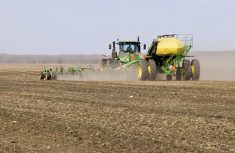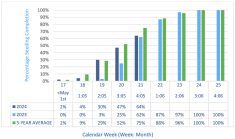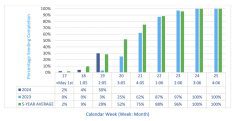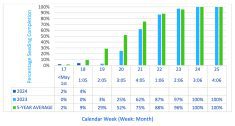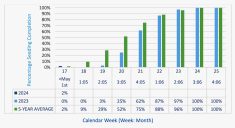Overview
Fungicide application is slowing across Manitoba, as crops grow past the appropriate timing windows. Producers have done much more fungicide application in 2022 than in recent years.
A few insect concerns have popped up in localized spots across Manitoba, with bertha armyworm spraying reported in the Eastern region.
Read Also

Agriculture remembers Rosalie Tennison
Rosalie Tennison, a Manitoba agricultural journalist and author, has died after being struck by a vehicle in Winnipeg Nov. 21.
Soybean and pea aphids have been found in those crops, with pea aphid insecticide spraying often occurring with the fungicide pass. Soybean aphids have showed up in localized spots, and remain below thresholds but should be monitored closely.
Grasshopper pest species are present in all regions – mostly confined to field edges and headlands. Feeding damage varies, and has generally remained below economic levels for this time of the season, but some spraying is required.
Some crop protection companies are closely watching local insecticide supplies, as supply chain issues persist and increased demand have stretched supplies.
The Manitoba Crop Pest Update publishes detailed information each Wednesday on insect, disease and weed issues in the province.
Crop quality varies widely, with southern areas of the province in better condition than areas further north, all dependent on rainfall accumulation and speed of drainage.
Cereals
Small grains
Most spring wheat fields have completed flowering and kernel development is underway. The majority of the later seeded wheat has finished flowering. The spring wheat crop is rated mostly good to excellent, with some exceptions due to extreme moisture.
Fusarium head blight fungicide application in spring wheat is complete.
Armyworm damage on cereals has been discovered in the Beausejour area, control is underway as needed on specific fields where careful scouting was required.
Higher wheat midge counts were observed in the Roblin areas.
Barley crops range from flowering to head filling (milky dough) stages, with malt crops most advanced, and greenfeed or very late-seeded fields further behind.
Oat crops have finished flowering and are becoming heavier with grain fill developing.
Fall rye is turning colour and is at the hard dough stage, leaves have dropped off and stems are browning.
Winter wheat has mostly reached the hard dough stage, the crop is starting to turn colour. Pre-harvest aid application could start this week in the Eastern region.
Corn
Corn development ranges from VT (tasselling) to R2 (blister stage). Rapid dry matter accumulation is beginning, and nutrient demand will be highest in the next 30 to 40 days.
Corn crops in the Red River Valley are most advanced (R1 to R2), followed by corn in the Southwest and Eastern regions (VT to R1).
Most corn crops are quite tall, and more residue is expected this year and may require burning to manage if post-harvest tillage cannot be done ahead of winter snows.
Oilseeds
Canola crops are variable across Manitoba, with some in excellent condition and others in poor condition with thin stands. Flowering ranges from the start of blooming to completely finished bloom and fully podded.
Flowering is complete in parts of the Central and Northwest regions, while broad areas of the Eastern, Southwest and Northwest regions are still in mid-bloom.
Canola crop ratings are broadly estimated as 15% excellent, 60% good, and 25% fair condition.
Early crops have podded up well, with limited heat blast and flower abortion this year, and producers are watching crop development closely.
Fungicide applications are ongoing in the latest-seeded canola, while the majority of fungicide applications are complete.
With rising diamondback moth larvae levels, the Prairie Pest Monitoring Network states that
Flax crops are nearly done flowering, boll development looks good and disease issues are limited. Flowering appeared to be somewhat extended after rainfall encouraged more blooms following a week of very high temperatures.
Sunflowers are at the R4 to R5 stages, with flowers starting to open this past week on the most advanced fields. Fungicide application on sunflowers will start towards the end of this week.
Pulses
Soybeans are growing rapidly and have reached the R2 to R5 stage, with many crops planted in 30” rows closing canopy. Crop development has moved very quickly, almost at ‘normal’ for the time of year.
Some reports of soybean aphid in the Central, Eastern and Southwest regions, with a few fields approaching economic action threshold levels.
The majority of field peas range from flowering to R3 (flat pod stage) to R4 (full pod). Later seeded fields are further behind, while some well-developed crops continue to flower amid favourable growing conditions.
Excess rainfall has led to root rot in poorly drained fields or areas of fields. Yellow areas are evident in low spots and drains.
Pea aphids have been noticeable in some pea crops, with control occurring in some fields as required.
Dry bean stage ranges from R2 and R3. Spraying for white mould suppression is complete, and disease infection was limited this year, as conditions and high heat did not align for disease development.
The earliest dry bean crops in the Southwest region are approximately 3 weeks away from harvest.
Forages & livestock
Forages
First cut haying is wrapping up, except where rains and wet field conditions have slowed progress. Yields are above average and significantly better than last year, generally over 2 to 2.5 short (US) tons per acre.
More hay has been harvested as round bale silage than normal due to wet weather.
Second cut regrowth is doing very well, and haying has just started with dairy producers and will be
widespread soon.
Soft fields and lack of bale removal from first cut is hampering second cut start in the Eastern and Interlake regions.
Wild (native) hay fields are wet, and harvest will be limited unless it dries up.
Livestock
Pasture growth has slowed, as expected for mid-summer and cattle feed supplies are adequate.
All creeks, streams, dugouts, and sloughs are full and livestock water supplies are sufficient.
Regional comments
Southwest
Minimal to moderate rain fell this past week across the majority of the region, except for heavy rains in pockets near Riding Mountain National Park, and west toward Russell, with amounts up to 50 mm. No wind or hail damaged reported this week. In general, crops look good with above average yield potential at this point, but remain two to three weeks behind normal in most areas and will need good weather conditions in next month or two for maximum yield and to reduce the risk of frost damage.
Northwest
Generally cooler days this week with scattered showers throughout the week, ending with heavy rain Saturday night across the region. Rainfall amounts were heaviest in Roblin area with accumulated amounts of 75 mm; several days saw daily highs nearing 30°C. Overnight temperatures have also been cooler this week, hovering slightly above 10°C, however a couple nights have dipped down as low as 5°C in the Swan Valley.
Heavy rain and wind over the weekend has caused some lodging in cereal crops – some fields have been entirely flattened while some have portions of the field flattened. This may affect spring wheat quality and yield. Haying operations have been delayed multiple times, are just resuming now in the Ethelbert and Pine River areas.
Central
Hot, humid days drove rapid crop development across the region, punctuated by rainfall. Corn and soybean crops have advanced the most quickly, and are rapidly silking and developing pods, respectively. Spring wheat is just beginning to turn colour, and winter cereals await a pre-harvest aid in the next one to two weeks. Soil conditions have adequate moisture in the southern part of the region, while soils remain adequately moist to saturated further north. Farmers have generally been pleased with crop development, despite the challenging spring. Lodged crops have recovered somewhat, with cereals bouncing back better than lodged canola. Adequate rain will mean much- improved yields over 2021, but thunderstorm systems spur lodging events that might limit crop quality and make harvest pickup a little more difficult.
Eastern
Rainfall accumulations ranged from less than 20 mm to over 35 mm. Most of the rainfall fell during the middle of last week as part of various downpours and thunderstorms. Temperatures were also highly variable with both above and below seasonal daytime highs, humidity remained very high. Weather has worked to delay both spraying and hay-making and producers have had to make the most of any opportunity. Aerial application of fungicides and insecticides has been much more common this year.
Interlake
Heavy rainfall again soaked the Interlake region, bringing over 50 mm rain to the Fisherton area, and lower amounts throughout the rest of the region. Standing water is present in fields once again. Despite excessive rain, crops that have not drowned out and are sitting in drier spots of fields have advanced well. Forage seed harvest has been hampered by wet soil surface conditions, leading to stuck swathers and combines, and parts of fields that remain inaccessible.


